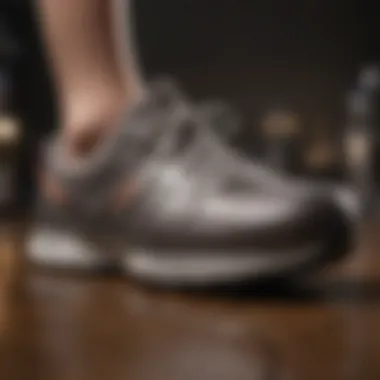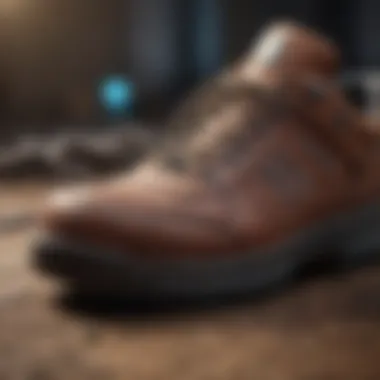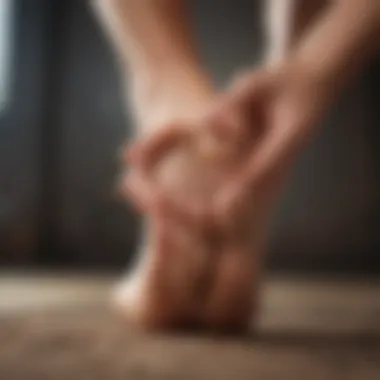Best Shoes for Male Nurses with Flat Feet: A Comprehensive Guide


Intro
Selecting proper footwear is essential for male nurses who have flat feet. This condition can lead to discomfort, fatigue, or even long-term complications, particularly given the demanding nature of nursing. Recognizing this need, the goal is to present a guide focused on supportive shoes that accommodate the unique needs of flat feet. We will delve into details on key features in footwear, alongside an evaluation of popular brands and models. This exploration will underscore function over form, aiming to enhance overall work experience and foot health for male nurses.
Key Features to Look for in Supportive Shoes
When seeking shoes for flat feet, several pivotal elements must be considered. Each feature plays a vital role in ensuring both comfort and effectiveness.
- Arch Support: It's crucial for shoes to provide adequate arch support. This feature helps distribute weight evenly, thus reducing strain on different foot areas.
- Cushioning: Proper cushioning in shoes assists in absorbing impact, mitigating stress on the feet during prolonged standing or walking.
- Stability: A stable shoe structure can aid in reducing the risk of overpronation—which can exacerbate symptoms of flat feet.
- Fit: A well-fitting shoe ensures that toes have enough space to move and that the heel is snug. Ill-fitting shoes lead to discomfort and may worsen existing foot issues.
- Breathability: Material that allows air circulation around the foot is essencial. It helps to keep feet dry and prevents excessive sweating, thus enhancing comfort throughout long shifts.
By understanding the significance of these features, male nurses can make more informed purchasing decisions.
Recommended Brands and Models
In terms of viable options, several brands stand out for their commitment to quality and comfort. Here are some notable recommendations that cater specifically to men with flat feet:
- Brooks Ghost 14: This running shoe features dynamic cushioning and excellent arch support, designed for comfort during prolonged wear.
- Asics Gel-Kayano 28: Favored for its support and stability, the Kayano provides structure while promoting natural foot motion.
- New Balance 990v5: With a reputation for cushioned footwear, the 990v5 offers splendid comfort while ensuring sufficient support for flat feet.
- SKECHERS Arch Fit: Specifically molded for arch support, this brand provides extra flexibility and cushioning suited for daily use.
Choosing the right pair can greatly influence overall foot health and reduce discomfort over long working hours.
Finding the right shoes makes a significant impact, not just on physical health, but also on job performance.
Foot Care Insights
Maintaining foot health is crucial, especially for nurses who spend extended hours on their feet. Here are some basic tips to enhance foot care:
- Regular Inspection: Check your feet regularly for any signs of discomfort or injury. Early detection is key to managing flat feet symptoms.
- Proper Hygiene: Keeping feet clean and dry helps prevent infections, especially given communal workplace environments.
- Stretching Exercises: Simple exercises can assist in maintaining foot flexibility and strength, improving overall well-being.
By embedding these practices into daily routines, the overall quality of foot health may improve.
Final Thoughts
This guide elucidates the journey toward selecting proper footwear for the male nursing workforce with flat feet. The relevance is clear: appropriate shoes not only directly influence foot health, but also the emotional and psychological well-being of the individual. Through informed choices and proactive foot care, nursing practitioners can better manage the demands of their work environment, paving the way for enhanced comfort and efficacy in their roles.
Understanding Flat Feet
Understanding flat feet is essential for male nurses, as the demands of the profession, coupled with this condition, can lead to significant discomfort and health issues. Flat feet, characterized by a collapse of the arch, can cause misalignment and pain in various parts of the body. It is not just a structural concern; the implications of flat feet may affect a nurse's mobility, endurance, and overall work performance.
Definition and Causes
Flat feet, also known as pes planus, entail the complete or partial alignment of the foot arch, where the arch looks lower than normal.
Several factors contribute to flat feet, such as:
- Genetics: Often, flat feet are hereditary. If there is a history of the condition in your family, you are at a higher risk.
- Developmental Issues: The feet develop arches in early childhood. Sometimes, these arches fail to develop properly.
- Injuries: Trauma to the foot can damage the arch and lead to flat feet.
- Aging: As one ages, muscles and tendons lose flexibility and strength. This decline can cause the arches to collapse.
- Obesity: Excess weight puts additional pressure on the feet, potentially flattening the arch.
Other causes may include certain medical conditions, such as rheumatoid arthritis or diabetes.
Impacts on Daily Activities
Flat feet can have a plethora of consequences that influence daily activities. Here are a few noted impacts:
- Pain: Pain in the feet, ankles, knees, and lower back occurs frequently in male nurses with flat feet. Discomfort can complicate long shifts spent on foot, leading to shortened work sessions or increased fatigue.
- Fatigue: A lack of proper arch support can lead to increased fatigue during long shifts due to inefficiences in how muscles are used.
- Reduced Stability: Decreased arch flexibility is linked to stability. This reduced balance raises the risk of falls or injuries, especially in demanding environments like hospitals.
- Limited Activity Choices: Individuals may avoid certain physical activities, fearing exacerbation of foot pain.
In sum, the understanding of flat feet helps to inform the selection of appropriate footwear, which is crucial for comfort and functionality in workplace settings.
The Role of Footwear in Foot Health
Footwear plays a fundamental role in maintaining foot health, particularly for individuals like male nurss who spend long hours on their feet. The type of shoe worn can significantly influence comfort, injury prevention, and overall well-being. For those experiencing flat feet, this significance magnifies. Proper shoes can help mitigate discomfort and support proper alignment of the body, which is vital in a demanding job.


Importance of Supportive Shoes
Supportive shoes are crucial for male nurses. These shoes can help distribute weight evenly, which reduces stress on the feet and reduces the risk of conditions such as plantar fasciitis. Footwear with appropriate arch support manages the foot's natural alignment, allowing for better biomechanics. The proper soles are needed for stability and approach anything related to so-called pronation, the internal rolling of the foot during movements. ``Supportive shoes can improve performance'' and decrease fatigue during long shifts.
Key features of supportive shoes are:
- Arch Support: Provides the necessary cushion and lift, preventing the foot from flattening excessively.
- Cushioning: Absorbs impact, offering comfort and reducing strain on joints.
- Stability: Assists in maintaining balance while on the move.
- Fitting: A snug fit ensures that the shoes do not slide, providing individual support.
In sum, wearing supportive shoes not only helps in alleviating discomfort but also enhances productivity onsight. With their importance established, it’s vital for male nurses to ensure that their footwwear aligns well with their unique foot anatomy when tackling their professional duties.
Consequences of Poor Footwear Choices
Choosing poor footwear can have several negative repercussions, especially for male nurses who suffer from flat feet. When shoes don’t provide sufficient support, it can lead to several consequences, including:
- Foot Pain: Increased discomfort can occur, affecting the ability to perform daily tasks. Over time, unaddressed pain can lead to chronic issues.
- Muscle Fatigue: Poor shoes can strain muscles and joints, causing them to tire quickly.
- Injuries: Improper support can lead to various injuries, ranging from sprains to stress fractures. This is especially true during fast-paced shifts that require running or quick movements.
- Postural Problems: Misalignment due to lack of support can affect back, hip, and knee pain, translating to fewer gerations.
A study on foot health showed that supportive footwear can reduce injury rates among high-risk occupations, highlighting the necessity of making informed choices concerning shoes. Infusing this with the important of essential foot care can provide a realistic approach for sustaining energy and preventing future health issues, contributing to both longevity in the profession and better health outcomes.
Key Features to Consider
When selecting shoes for male nurses with flat feet, a few specific features can greatly enhance comfort and support. Understanding these elements ensures that shoes not only fit well but also provide much-needed relief during long shifts. Proper footwear can mitigate discomfort and reduce the risk of long-term health issues associated with flat feet.
Arch Support
Arch support is fundamental for any individual suffering from flat feet. The arch, often nonexistent in flat-footed persons, plays a crucial role in weight distribution. Without sufficient support, the body may compensate in unnatural ways, often causing pain in the feet, knees, and back.
Footwear that offers adequate arch support helps in aligning the foot properly. This alignment contributes to overall biomechanical efficiency, which decreases fatigue.
For example:
- Shoes with built-in arch support can enhance stability.
- They also lower the chances of developing other conditions, like plantar fasciitis.
Consider shoes that match the contours of your feet comfortably yet securely. Some brands allow you to customize insoles based on individual arch shape, adding an extra layer of support where needed.
Cushioning
Cushioning is another critical factor in the selection of shoes for nurses. Proper cushioning absorbs impact, which is essential for those spending hours on their feet. Ideal footwear should feature responsive cushioning to soften the landing for each step.
Good cushioning can prevent numerous problems experienced by flat-footed individuals, such as:
- Foot fatigue
- Joint numbness
- Stress fractures
Look for shoes that are made with materials that enhance both comfort and longevity in cushioning. Memory foam is one such material that adapts well to foot anatomy, providing excellent pressure relief throughout shifts.
Stability and Motion Control
Stability and motion control work hand in hand to provide balance during movement. Shoes designed for stability often have a wider base, which aids in better weight distribution. It’s crucial for minimizing ankle sprains and other injuries. Motion control features ensure that the foot remains aligned no matter the foot's motion, effectively reducing the average pronation that commonly comes with flat feet.
Responsiveness to lateral movements can be vital for male nurses who often shift between surgery rooms, emergency departments, and wards. The right shoes can engage stability features such as:
- Firm heel counters
- Structured midsoles
These elements can contribute positively to both safety and comfort during demanding tasks.
Durability
Choosing durable shoes may save time and money in the long run. Nursing work involves high stress, and shoes often face harsh conditions. Consider materials that prioritize respect for the individual’s investments in their health. Enhanced durability means that shoes can withstand:
- Frequent use
- Potential spills
- General wear-and-tear


Brands that manufacture shoes ensuring durability often use strong materials such as leather or synthetic fabrics that resist not only wear but can also moisture, stain or weather damage.
Breathability
Lastly, breathability is a significant factor, especially in nursing. The feet can become considerably warm, leading to discomfort. Shoes that prioritize airflow tend to keep feet cooler and drier, improving overall comfort levels.
Look for mesh uppers or ventilation holes that allow humidity and temperature control within shoes. Properly designed holes prevent swetery feeling feet, which can be highly distracting during extensive work hours.
Ultimately, integrating these features into the shoes can lead to significant improvements in the comfort and health of male nurses battling with flat feet.
Popular Shoe Brands for Male Nurses
Selecting the right footwear is crucial for male nurses, particularly those with flat feet. The demands of a nursing profession require shoes that offer more than just style; they must provide comfort, support, and durability. In this context, focusing on proven shoe brands becomes essential. Reputable brands often design shoes with the nuanced needs of healthcare professionals in mind. Specialized features in these shoes can positively impact foot health and overall well-being, which directly correlates to job performance and patient care.
New Balance
New Balance is recognized for its supportive performance running shoes that also cater to the workload of nurses. Their footwear range includes models that focus on stability, arch support, and cushioning. Having a firm but comfortable base is essential for flat-footed individuals, and New Balance tends to offer a variety of widths to enhance fit.
Models like the New Balance 990v5 have received praise for their combination of support and comfort, essential for long hours on the job. The brand’s dedication to quality has established it as a favorite among those seeking reliable footwear.
ASICS
ASICS is another standout brand increasingly popular among male nurses. Their shoes prioritize comfort and stability, making them suitable for those with flat feet. A well-known model is the ASICS GEL-Kayano, known for its integrated cushioning technology.
The emphasis on shock absorption and arch support translates well into the demanding environment of nursing. Additionally, ASICS often incorporates breathable materials into their shoes, keeping feet cool during long shifts.
Brooks
Brooks rightly earns a spot in this discussion with its commitment to creating exceptional performance running shoes. The Brooks Addiction Walker is especially designed for those with flat feet. High stability and arch support make this model an optimal choice for long hours.
Many users report positive experiences ranging from pain reduction in the foot area to overall improved comfort. For nurses on their feet all day, these benefits are indispensable.
Saucony
Saucony shoes synthesize excellent performance while addressing specific requirements for flat-footed wearers. Their Zealot and Omni models focus on plush cushioning and stability.
The unique technology incorporated into these shoes also aids in motion control and consistent support. Saucony’s history of innovation in creating effective running shoes adds value and reliability that male nurses can trust in their daily operations.
Skechers Work
Now, Skechers Work presents a compelling case for footwear designed specifically for professionals operating in challenging environments. Utilizing memory foam and solid construction, Skechers creates shoes that are lightweight yet supportive.
Models like Skechers Work: Sure Track stand out for their comfort profiles and slip-resistant soles, making them well-suited for hospital floors. This brand’s approach caters directly to nurses’ needs, focusing on flexibility without sacrificing support or safety.
> Proper footwear is indispensable in occupational health. Choose wisely for better well-being.
In sum, selecting shoes from leading brands greatly impacts foot health and function for male nurses, particularly those experiencing flat feet. Overall, it’s vital to explore each option while considering comprehensive support and comfort.
Evaluating Specific Models
Choosing the right shoes is essential for male nurses, especially those with flat feet. Evaluating specific models not only simplifies the shopping process but also helps in identifying which footwear qualities address individual needs. Male nurses often spend extended hours on their feet, making all facets of shoe characteristics crucial for comfort and effectiveness. Prominent features such as arch support, durability, and cushioning become even more pertinent when selecting specific shoe models.
Above all, assessing models will align their performance with the often demanding daily routines nurses face in their jobs. This section will present not just popular choices but will break down critical attributes that male nurses must consider in their buying choices.
Top Picks
Model Overview
When discussing the model overview for shoe selections, it is important to emphasize the aspects that contribute to overall comfort and support for male nurses. A good model typically provides exceptional arch support suited for flat feet. One notable model is the New Balance 990v5, a robust choice known for its cushioning technology. It provides a stable base which is needful for foundation balance. In addition, the durability of its upper material is significant for all day wear,


Performance Ratings
The performance ratings of a shoe determine how it meets the expectations set in the healthcare environment. A single evaluation might encapsulate factors like comfort, breathability, and slip resistance. For example, the ASICS Gel-Kayano 27 scores high on these areas, especially due to its gel cushioning system, ensuring prolonged comfort. Such performance characterizations serve as guides to show how well a shoe can handle the rigors of nursing tasks.
Price Point
The price point ultimately informs personal choices related to budgeting. It is vital for male nurses to weigh the cost relating to the shoe's overall quality. Brands like Brooks tend to offer shoes that balance costs with performance, like the Brooks Ghost 13, making it a favored model. The initial investment may appear elevated initially, but its durability and support can reduce the frequency of needing replacements. Understanding these dynamics is crucial when discussing footwear financial commitments.
Customer Reviews
When evaluating from customer reviews, feedback provides significant insights regarding real-world performance. Male nurses substantiating a product can offer invaluable perspectives. Reviews often cover durability and break-in periods that are pivotal for effective performance. New Balance users frequently report favorable outcomes highlighting comfort during long shifts. Hence, gathering this feedback plays a vital role in the decision-making process when selecting nursing shoes that last.
Proper Care and Maintenance
Proper care and maintenance for shoes is crucial for male nurses with flat feet. Those who face the challenges of flat feet need suitable footwear not only for comfort but for their overall health. Proper shoe care extends the life of the shoes and can prevent common foot problems associated with dysfunctional arches. Wearing good shoes is just part of the solution; maintaining their quality ensures long-lasting support and pain alleviation.
Cleaning Techniques
Keeping shoes clean is important. Appropriate cleaning methods remove dirt and sweat that accumulate during long shifts. Here are few techniques:
- Spot Cleaning: Use mild soap and damp cloth to clean the outer surfaces while avoiding excessive water exposure.
- Deodorizing: Applying baking soda inside the shoes can help absorb odors. Leave it overnight and shake out the excess.
- Regular Maintenance: Pay attention to your shoes after each working day. Regular spot checks for fabric damage, and sole integrity are necessary to maintain performance.
Different materials require specific treatments, so be sure to consider the material of your shoes when choosing cleaning solutions. Simple cleaning steps can extend the comfort of wearing them.
Storage Recommendations
Storage plays a vital role in preserving shoe integrity. Here are outlined best practices for storing your nursing shoes:
- Avoid Compression: Do not stack heavy items on top of your shoes as this can cause the structure to warp, especially for cushioned models.
- Air Dry: Always air dry your shoes after cleaning or if they become wet. Putting them near a heater can harm materials.
- Use a Shoe Rack: Keeping your shoes organized and away from direct sunlight helps in preventing fading and cracking.
The End
Supportive shoes assist in maintaining proper posture. They mitigate discomfort that can develop into more serious musculoskeletal issues. Addressing these specific concerns aid medical professionals in executing their duties efficiently.
This implies that investing in quality footwear is not merely a personal choice but a professional necessity.
In keeping with both functionality and comfort, we provided insights into features that matter. Priority elements such as arch support, cushioning, and breathability were highlighted. Each of these aligns with the unique needs of professionals coping with flat feet.
Final Recommendations
Among the popular brands, certain models stand out. When selecting shoes, always prioritize specific features. Look for ample cushioning and arch support tailored to flat feet. Make use of this guide by keeping in mind durable options from renowned manufacturers like New Balance and ASICS. Also, consider reading customer reviews.
Caring for your shoes ends up being essential for longevity and effectiveness. Being proactive in maintenance ensures that your foot health is supported over time. Each aspect matters, so please take the time to evaluate options available to you. By making informed decisions, male nurses can promote their comfort, lower the risk for future injuries, and be better prepared for their demanding roles.
Further Resources
Understanding how to choose the right shoes for male nurses with flat feet is enhanced by the availability of further resources. These resources provide deeper dives into specific subjects, extending knowledge beyond shoes alone. They connect foot health and well-being and the implications involved in an individual’s occupational demands.
Expert Articles
Expert articles are invaluable for gaining clarity on footwear for flat feet. These writings often feature insights from podiatrists, physiotherapists, and other healthcare professionals. By presenting research, case studies, and evidence-based recommendations, expert articles equip readers with substantial information. Each article often breaks down material into comprehensible sections, allowing practitioners to grasp complex ideas with ease.
Here are some key benefits of expert articles:
- Studies and Findings: They discuss clinical findings on how various shoe features, such as arch support and cushioning, positively influence foot health.
- Practical Tips: Many articles include practical advice on necessary steps to improve foot comfort while at work.
- Latest Trends: Upcoming trends in shoe technology also get highlighted, leading to innovative options on the market.
- Personal Experiences: Supplies anecdotes and peer discussions relevant to flat feet and nursing.
You can find a plethora of expert articles on reputable platforms like Wikipedia and Britannica. These sites offer authoritative perspectives on the topic aligned with sound research and critcial insights.
Foot Health Organizations
Foot health organizations play a crucial role in disseminating useful information about maintaining foot wellness. They often conduct outreach programs and seminars aimed at educating both professionals and the lay public alike. Here are some aspects where they considerably contribute:
- Research Publications: Organizations like the American Podiatric Medical Association provide journals filled with comprehensive studies relevant to flat feet and footwear recommendations.
- Guidelines and Resources: They offer guidelines on choosing supportive footwear, emphasizing factors that aid in foot stability and comfort.
- Preventative Measures: Organizations frequently publish resources on preventative measures and rehabilitation techniques.
- Community Engagement: Many have forums where you can discuss specific questions or collaborate with like-minded individuals.
Navigatting these resources isn’t difficult. Websites of respective organizations are often user-friendly, allowing easy access to information. Thus, staying engaged with these organizations ensures ongoing education and support as it pertains to foot health.
Effective footwear, alongside expert advice, can significantly enhance your experience as a nurse with flat feet.







